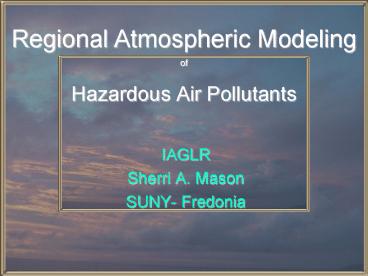Hazardous Air Pollutants - PowerPoint PPT Presentation
1 / 27
Title:
Hazardous Air Pollutants
Description:
Field measurements provide information about a particular (point) ... Advection. Diffusion. Photochemical Reactions. Gas-phase Heterogeneous. Aerosol Formation ... – PowerPoint PPT presentation
Number of Views:182
Avg rating:3.0/5.0
Title: Hazardous Air Pollutants
1
Hazardous Air Pollutants
Regional Atmospheric Modeling
of
- IAGLR
- Sherri A. Mason
- SUNY- Fredonia
2
Background
3
Why Model?
- Field measurements provide information about a
particular (point) location at a particular
moment in time - Models provide the causal link
- Emissions with Atmospheric Processes that lead to
Instantaneous Measurements
4
Atmospheric Processes
- Advection
- Diffusion
- Photochemical Reactions
- Gas-phase Heterogeneous
- Aerosol Formation
- Coagulation Condensation G/P partitioning
- Aerosol Chemistry
- Cloud Formation
- Deposition
- Wet Dry
5
Current State of Atmospheric Models
- Regional models do fairly well with species such
as CO, O3, and NOx - Criteria Air Pollutants (CAPs)
- Gas-phase species
- Not so good at modeling Aerosols
- Liquid or solid particles which remain suspended
in air - a.k.a. Particulate Matter (PM)
6
Atmospheric Processes
- Advection
- Diffusion
- Photochemical Reactions
- Gas-phase Heterogeneous
- Aerosol Formation
- Coagulation Condensation G/P partitioning
- Aerosol Chemistry
- Cloud Formation
- Deposition
- Wet Dry
7
Atmospheric Processes
- Advection
- Diffusion
- Photochemical Reactions
- Gas-phase Heterogeneous
- Aerosol Formation
- Coagulation Condensation G/P partitioning
- Aerosol Chemistry
- Cloud Formation
- Deposition
- Wet Dry
8
Atmospheric Processes
- Advection
- Diffusion
- Photochemical Reactions
- Gas-phase Heterogeneous
- Aerosol Formation
- Coagulation Condensation G/P partitioning
- Aerosol Chemistry
- Cloud Formation
- Deposition
- Wet Dry
9
Gas/Particle Partitioning
- Ideally, condensation requires
- ci gt ci,sat (at given T)
- Sorption processes, however, can act to
significantly lower this threshold - Lower the vapor pressure, the higher the
gas/particle partitioning coefficient - Known to be an important atmospheric process for
many HAP-species
10
Hazardous Air Pollutants
- EPA grouping of 188 pollutants, such as
- Benzene PAHs Mercury
- Ubiquitous Contaminates
- Long-Range Transport
- Health Issues
- Carcinogenic Mutagenic
- Cycling
- After initial deposition, many HAPs are
re-released back into the atmosphere
11
Current Project
12
Project Goals
- Inclusion of HAP species
- We are focused on 20
- Acetaldehyde Methanol
- Acrolein Methyl t-Butyl Ether
- Anthracene Napthalene
- Benzene Phenanthrene
- Benzo (G,H,I) Perylene Phenol
- Chlorobenzene Propionaldehyde
- Ethylbenzene Styrene
- Formaldehyde Toluene
- Methyl Ethyl Ketone Xylenes
- Mercury
13
Project Goals
- Inclusion of HAP species
- We are focused on 20
- Improve Aerosol Modeling
- Multi-phase G/P Partitioning Pankow 2004
- Evaluate Regional Model
- Using all available observational data sets
14
Modeling Framework
15
Project Specs
- Modeling Domain
- Eastern US
- Modeling Period
- Summer 2002
- Future Year
16
Current Status
17
Inclusion of HAP species
Emissions Modeling
18
Emissions Modeling
19
Emissions Modeling
- SMOKE processing of CAPs
- Run and Compare to DEC
- HAPs
- Finish GLC Point Source emission file
- SMOKE processing of CAPsHAPs
- Integrate HAP SMOKE input files with CAP SMOKE
input files - Run
- QA/QC
20
Improve Aerosol Modeling
- We have already modified the aerosol module of
CMAQ to account for the multi-phase G/P
partitioning - Need to
- Finish installing CMAQ on Reg
- Test module modification
21
Evaluate Regional Model
- We have compiled a significant portion of data
from on-going measurement campaigns - IMPROVE, NADP/MDN, IADN
- Field data of Holsen, Hopke and Milligan
- Data will be used to evaluate CMAQ results for
the Summer 2002
22
Support
- SUNY- Fredonia
- Nicholas Presutti, David Bronke
- NYS DEC
- Gopal Sistla, Kevin Civerolo, Christian Hogrefe,
Michael Ku, Winston Hao - GLC
- Jon Dettling
23
(No Transcript)
24
Emissions Modeling
- Emissions are reported on an
- annual basis by county as individual or group
25
Emissions Modeling
- Emissions are reported on an
- annual basis by county as individual or group
Yearly ? Hourly
26
Emissions Modeling
- Emissions are reported on an
- annual basis by county as individual or group
27
Emissions Modeling
- Emissions are reported on an
- annual basis by county as individual or group
Model Species































